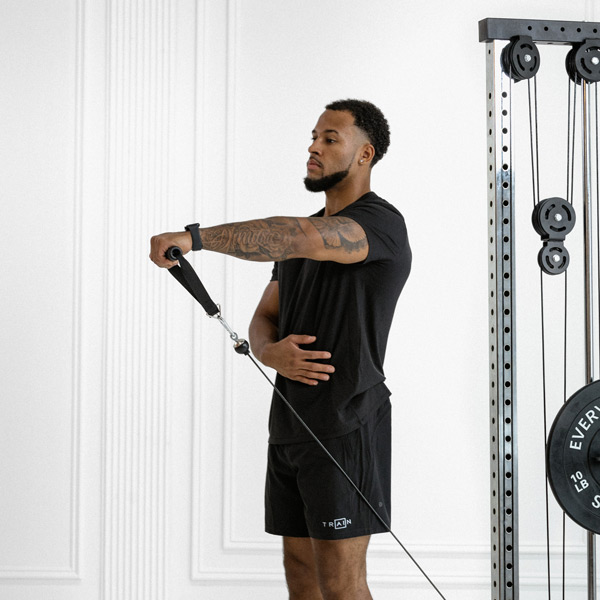Cable Front Raise Double Arm
Cable front raise isolates the anterior deltoids using a cable machine for constant tension, building shoulder strength and definition; ideal for hypertrophy in upper body workouts.
About Exercise
Equipment
Single Cable Machine
Difficulty
2/5 • Beginner
Primary Muscle Groups
Shoulders
Secondary Muscles
Shoulders, Traps, Biceps
Popularity Score
7
Goals
Training Style
Setup Requirements
Requires Rack
No
Requires Bench
No
Requires Spotter
No
Space Needed
Small
Noise Level
Low
Muscle Breakdown
View Muscle MapShoulders
10/10Anterior Delts
Chest
6/10Upper Chest
Shoulders
5/10Medial Delts
Traps
4/10Upper Traps
Biceps
3/10Programming
Typical Rep Range
8-15 reps
Rest Between Sets
60-90 seconds
How to Perform
Adjust cable pulley to lowest position and attach D-handle or straight bar. Stand facing away from machine with feet shoulder-width apart, grasping handle with overhand grip and slight elbow bend.
- Position handle at thigh level with arms extended.
- Exhale and raise handle forward to shoulder height, keeping arms nearly straight.
- Squeeze deltoids at top and hold briefly.
- Inhale and lower handle controlled back to start.
- Repeat for reps, maintaining core engagement.
Coaching Tips
Form Cues
- Lead with elbows
- Keep slight elbow bend
- Avoid swinging body
- Eyes forward
- Core tight
Breathing
Exhale during the lift and inhale during the descent while bracing your core.
Tempo
3-1-2
Range of Motion
Raise arms from thigh level to parallel with floor, avoiding elevation above shoulders.
Safety
Safety Notes
- Start with light weight
- Avoid shoulder impingement
- Keep wrists straight
- Stop if pain occurs
Spotting
Spotting not required; use machine safeties if needed.
Common Mistakes
- Using momentum to lift
- Locking elbows
- Raising above shoulder height
- Arched back
When to Avoid
- Shoulder impingement
- Recent shoulder injury
Flexibility Needed
- Shoulder flexion to 90 degrees
Build Up First
- Basic cable machine familiarity
Also known as
Cable Shoulder Front Raise, Front Delt Cable Raise, Standing Cable Raise
Found this helpful?
Share your thoughts or help us improve this guide.
Similar Exercises

Cable Single-Arm Front Raise

Single Cable Machine
Shoulders

Cable Single-Arm Lateral Raise

Single Cable Machine
Shoulders

Barbell Double-Arm Landmine Press

Barbell, Others
Shoulders

Plate Front Raise

Plates
Shoulders

Barbell Front Raise
Barbell, Plates
Shoulders

Dumbbell Front Raise

Dumbbells
Shoulders

Barbell Landmine Double Arm Squat Press

Barbell
Quads, Shoulders

Dumbbell Side Raise to Front Raise

Dumbbells
Shoulders

Resistance Band Front Raise
Bands
Shoulders

Barbell Incline Front Raise
Barbell, Incline Bench
Shoulders


subscribe to our newsletter
Contact Us
hello@trainfitness.aiFind Us
130 Spadina Avenue, Toronto,
Ontario, M5V 0H4, Canada
©2025 All Rights Reserved
